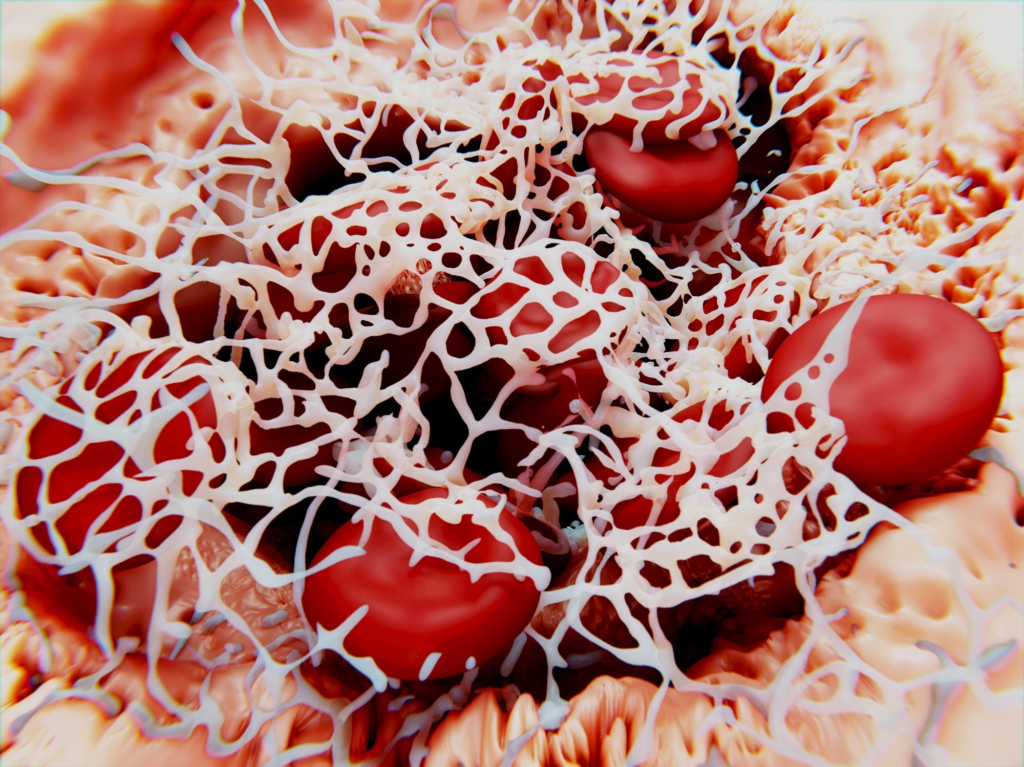By Vijay Kumar Malesu
Reviewed by Susha Cheriyedath, M.Sc.
Uncovering the molecular interactions between fibrin and the SARS-CoV-2 spike protein, researchers pave the way for targeted therapies that could curb the devastating effects of long COVID.

Fibrin drives thromboinflammation and neuropathology in COVID-19. Image Credit: Juan Gaertner / Shutterstock
In a recent study published in the journal Nature, a large team of researchers in the United States provided evidence that fibrin plays a pivotal role in driving thromboinflammation (the harmful interaction between clotting and inflammation) and neuropathology in Coronavirus disease 2019 (COVID-19). They also explored the potential of fibrin-targeting immunotherapy as a treatment for both acute COVID-19 and long COVID-19.
Background
Long COVID has become a significant public health concern, with coagulation and neurological complications arising during acute infection and persisting into the post-acute phase, contributing to morbidity and mortality. These issues affect patients across all age groups, including those with mild or breakthrough infections. Persistent and resistant blood clots, despite adequate anticoagulation, suggest underlying mechanisms that are not yet fully understood. The interaction between hypercoagulability, immune response, and neurological complications in COVID-19 highlights the need for further research to uncover the precise mechanisms driving these complications and to develop effective treatments.
About the study
C57BL/6 and K18-hACE2 mice were utilized in this study, obtained from Jackson Laboratory and other sources, and housed under standard conditions. Mice aged 3 to 7 months of both sexes were used for experiments conducted in an Association for Assessment and Accreditation of Laboratory Animal Care (AAALAC)-accredited Animal Biosafety Level 3 (ABSL3) facility at Gladstone Institutes, following institutional guidelines.
Human citrated plasma and Peripheral Blood Mononuclear Cells (PBMCs) were commercially sourced, with no human participants directly involved. The Severe Acute Respiratory Syndrome Coronavirus 2 (SARS-CoV-2) recombinant trimeric spike protein was produced in Chinese Hamster Ovary (CHO) cells, purified, and used in various assays.
Fibrin polymerization in human plasma was assessed by measuring turbidity after initiating clotting with thrombin and calcium chloride. Scanning electron microscopy (SEM) analyzed fibrin clots formed on silicon wafers, followed by image processing with National Institutes of Health (NIH) Images.
ELISA plates coated with fibrinogen or fibrin were used to study the specific binding interactions of the spike protein, detected with specific antibodies. Additional methods included peptide arrays, epitope mapping, alanine scanning, structural modeling, and docking studies to explore the precise regions within fibrinogen and spike that mediate their interaction.
In vivo experiments involved injecting labeled spike protein and fibrinogen into mice, followed by tissue imaging. Resistance of fibrin clots to plasmin digestion, reactive oxygen species (ROS) detection in macrophages, and various immunoassays were performed. Data analysis ensured statistical rigor, supporting the study’s robust conclusions.
Study results
Given the higher frequency and severity of abnormal blood clots in COVID-19 patients compared to other respiratory infections, it was hypothesized that SARS-CoV-2 might directly bind to fibrinogen, promoting clot formation and altering clot structure and function. A solid-phase binding assay confirmed the specific interaction between fibrinogen/fibrin and the SARS-CoV-2 spike protein, identifying key binding sites on both molecules. This included the spike S1(N501Y) mutant, which enhances viral transmission and binding to Angiotensin-Converting Enzyme 2 (ACE2). The affinity of the spike for fibrin was lower than for ACE2, yet fibrinogen was found to co-immunoprecipitate with the spike protein and co-localized with spike in the lungs of infected mice. This suggests that fibrin and spike interact both in solution and within tissues.
To further explore the binding regions, a custom fibrinogen peptide array identified key binding sites in the fibrinogen Bβ and γ chains, mapping these to specific regions on the spike protein. Computational docking provided models that demonstrated a close association between these binding sites, confirming the interaction at a molecular level.
Subsequent tests revealed that spike protein alters fibrin clot structure and increases clot turbidity, indicating denser and more resistant clots, as observed in thromboembolic diseases and in COVID-19 patients. Additionally, the spike delayed the degradation of fibrin by plasmin, further suggesting that the spike contributes to the formation of fibrinolysis-resistant clots. This resistance to degradation could be a key factor in the persistence of inflammation and clot-related complications in long COVID. Spike also enhanced fibrin-induced inflammation, as shown by increased ROS release from macrophages.
Mutagenesis studies pinpointed the interaction between spike and a specific epitope on the fibrinogen γ-chain, which is crucial for binding the CD11b receptor involved in immune activation. Blocking this specific epitope with a monoclonal antibody, 5B8, not only inhibited the fibrin-spike interaction but also reduced spike-enhanced ROS release, indicating a potential therapeutic mechanism to mitigate both clot formation and inflammation. In vivo, co-injection of fibrinogen and spike into the mouse brain increased fibrin-induced microglial reactivity, underscoring the pro-inflammatory role of fibrin in the presence of SARS-CoV-2 spike protein.
Conclusions
To summarize, the study reveals that fibrinogen plays a central role in driving thromboinflammation and neuropathology in COVID-19, not merely as a consequence of systemic inflammation but as an active participant in the disease process. Fibrinogen’s interaction with the SARS-CoV-2 spike protein leads to abnormal clot formation, hyperinflammation, and direct effects on microglia in the brain, contributing to the neurological symptoms observed in COVID-19. The 5B8 anti-fibrin antibody was found to block many of these pathological effects, providing dual protection by reducing both thromboinflammation and neurodegeneration. Fibrin’s suppression of NK cell activity further highlights its role in modulating the immune response, potentially impairing viral clearance and exacerbating disease severity. This mechanism could be significant in both acute and long COVID, where persistent fibrin deposition may contribute to ongoing inflammation and cognitive decline. The study also points to the potential for fibrin-targeting therapies to reduce thromboinflammation and protect against neurological damage in COVID-19 without compromising normal hemostasis, offering a promising therapeutic avenue for patients suffering from the long-term effects of COVID-19.
Journal reference:
Ryu, J.K., Yan, Z., Montano, M. et al. Fibrin drives thromboinflammation and neuropathology in COVID-19. Nature (2024). DOI: 10.1038/s41586-024-07873-4, https://www.nature.com/articles/s41586-024-07873-4

Leave a Reply